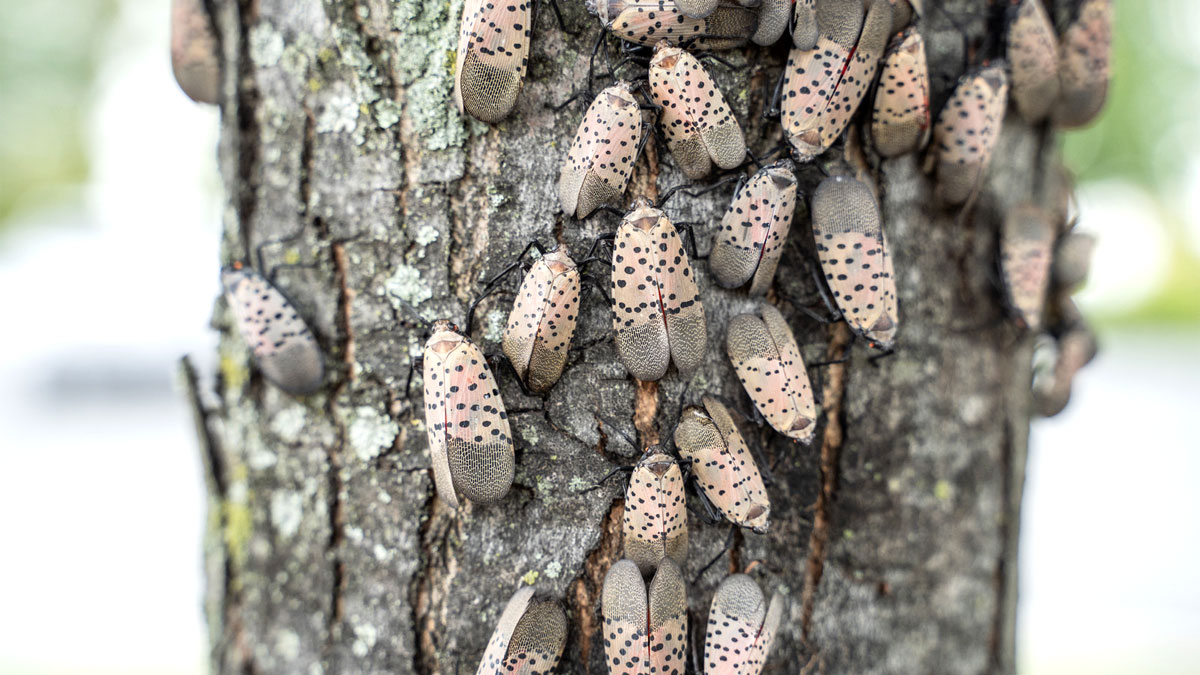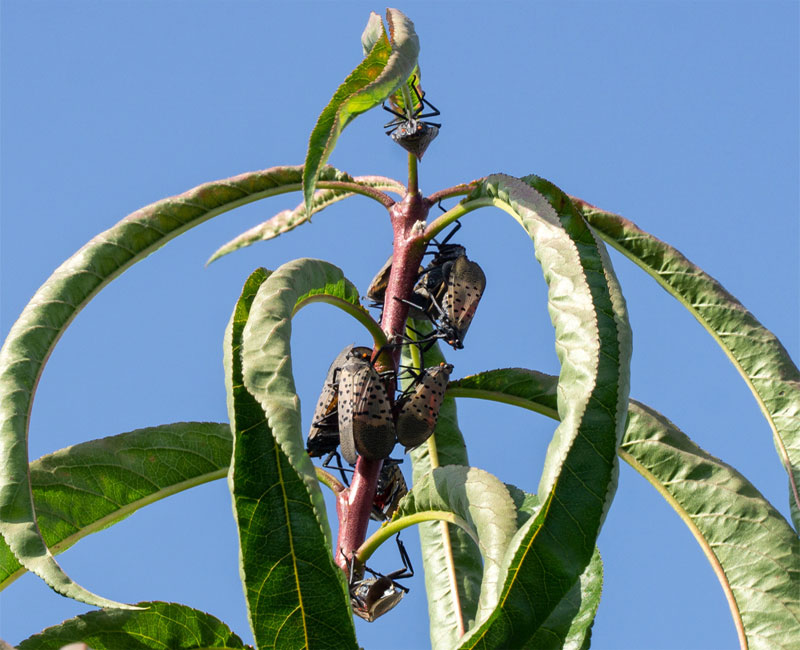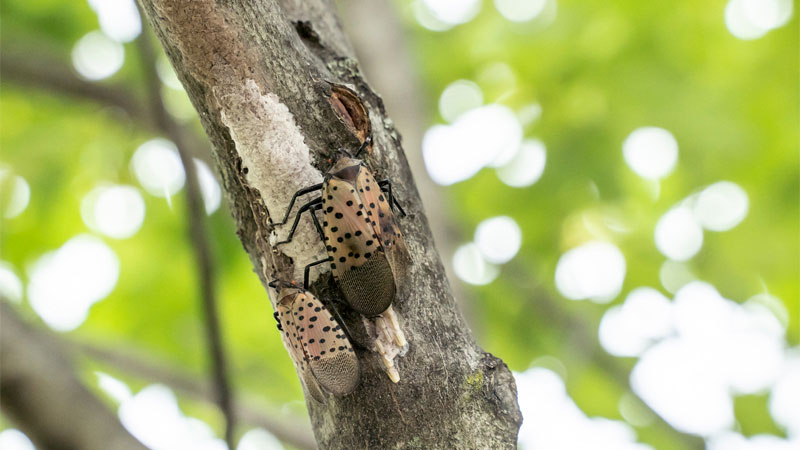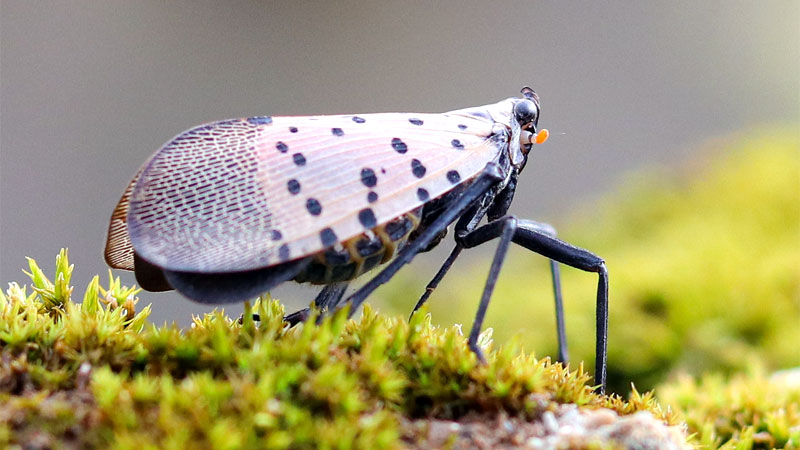Say the word fly and the only two groups of people getting excited are scientists and people wielding their Bug-A-Salt. But the spotted lanternfly is only exciting for the latter and dreaded by everyone else.
Let’s take a look as to why it’s so disliked at how to get rid of lanternflies when they invade your home or property.
What Damage Do Lanternflies Cause?
As with other piercing insects such as aphids, mealybugs, or scale, the lanternfly feeds on plant sap. They poke holes in your plants, sucking out the lifeblood. This can weaken a plant and make it more vulnerable to disease.
Some species of plants are more resilient than others to this kind of attack. For example, tree trunks can be peppered with lanternflies and fare better than a small shrub with only a few lanternflies on it. However, infested trees will still become weakened and may suffer from defoliation or other side effects.
Another problem that affects both host trees and other plants is lanternfly excrement. as with other piercing insects, the spotted lanternfly poops out partially digested sap, known as honeydew. Honeydew is a perfect breeding ground for fungal growths such as powdery mildew and sooty mold.
An Ironic Exception
Pennsylvania was the first place in the New world to discover spotted lanternflies and thus appeared to be at the greatest risk. However, something unusual happened. Bees are known to sometimes harvest honeydew when collecting pollen and nectar. As a result, honey is often contaminated with honeydew.
What Pennsylvanian apiaries discovered was that consumers prefer the taste of honey that contains lanternfly honeydew over the more common aphid honeydew. Of course, this doesn’t mean the United States will suddenly consider spotted lanternflies to be beneficial insects, but it does prove they’re completely without benefit.
Getting Rid of Lanternflies
Now’s the tough part. How do you deal with a highly destructive pest that will lay its egg masses on any available flat surface? Despite quarantines and numerous other measures, the Agricultural Department has been unable to eliminate lanternflies, so what chance to you have?
Well here’s the good news: Those egg masses are the reason population control has been such a problem, but you can easily take steps to stop this nasty little critter from laying them in the first place.
There are Always Exceptions
Here at RMC, we always advocate for no-kill solutions when possible. However, spotted lanternflies are highly invasive, highly destructive, and not endangered in their native habitat. In other words, This is an SOS (shoot on sight) critter.
Killing Lanternflies in the Lawn and Garden
There are a lot of ways to combat lanternflies on your property. Keep in mind, you’ll mostly find the nymphs unless you have some infested trees. If you’re (un)lucky, you might spot some egg masses as well. Here are some quick and dirty elimination techniques.
Insecticides
Whether you go with natural or chemical, this is a good way to kill a lot in a short time. Just remember that you can also harm beneficial insects if you aren’t careful. We recommend a neem soil soak, as systemic insecticides are safest.
Alternatively, you can use insecticidal soap or chemical solutions (don’t forget to rotate brands to prevent superbugs!).
Monster Mash
It might take a little practice, but you can easily stomp the nymphs out of existence. Unlike roaches, they’re not very fast. However, they’re known to hop away at the last moment, so stomp hard and fast!
Natural Enemies
In their native habitat, parasitic wasps keep the lanternfly population under control. However, you can also employ insectivore birds, lizards, frogs, spiders, and even yellow jackets to fight these invaders.
Shoot ‘Em Up
Grab your Bug-A-Salt and go to town. You’ll want at least the version 2.5 to tackle the fourth instar or adults. You can also grab a couple SHRED-ERs and make it a Texas shoot out.
Of course, if you don’t have these weapons of pest destruction (WPDs), you can always use electrified rackets, fly swatters, or a classic rolled-up newspaper.
Soapy Water
Adding Dawn dish soap or some other liquid soap to water can make an easy killer. Either spray or knock the lanternflies into the water to kill them.
Sticky Traps
Inward-facing sticky traps may work against adults. However, regular sticky traps will work against the instars. Add a touch of spearmint oil to lure them in.
Killing Indoors
If lanternflies get in homes or vehicles, you can also use a vacuum. Be sure to double-bag and dispose.
Getting to Know Lanternflies
The spotted lanternfly is the only species currently found in North America, and it’s a doozy! Here’s everything you need to know to identify a lanternfly and why it’s a nasty critter to encounter.
What is the Lanternfly?
Lanternflies belong to the genus Lycorma and are all native to Asia. In particular, the spotted lanternfly (Lycorma delicatula) is a highly invasive species that now threatens much of the US.
Originally found in parts of China and Vietnam, this species recently began to invade South Korea and Japan. Specimens were first spotted (no pun intended) in Pennsylvania in 2014. Fast forward only eight years, and the spotted lanternfly has become such a threat that both state and Federal actions are being taken.
Despite having the word “fly” in their name, lanternflies are actually a type of leafhopper, AKA an insect from the infraorder Fulgoromorpha. These insects are known to blend into plant life by having camouflage or being shaped like sticks or leaves. In the case of the spotted lanternfly, only the adults blend in… sort of.
The Many Faces of Spotted Lanternflies
Lanternflies have three very distinct appearances which change based on their life stage. Nymphs go through four instars. During the first three instars, they’re black with white spots. By the end of the third instar, they’re only 1/4 inches long.
The fourth instar is completely different. these double in size to 1/2 inches long and are red with some black bits and white spots. Chances are, you’ll mostly spot the third and fourth instars of this invasive pest.
Adult lanternflies again seem to change completely. At just under an inch long (with females being slightly larger than males), they’re easily mistaken for moths. The forewings are a light gray-brown with spots and darker tips.
The way they hold their wings, along with their black heads, are very moth-like. The wings also allow them to blend in with tree bark.
However, these little pests are hiding a secret. Their hind wings have black tips and a crimson red interior with black spots. A band of white separates the zones. If the lanternfly gets excited, they’ll spread their wings to startle predators.
How Long Do Spotted Lanternflies Live?
The eggs hatch around late April to early May. By July, adults have already begun their mating flights, which can continue into August. Copulation takes around four hours.
Between early September and the beginning of winter, female lanternflies will lay egg cases containing 30 to 50 eggs. Most adults will die before the end of December, and none are known to survive more than a year.
Research suggests that the eggs fare better in long winters, during which they remain in diapause. Sustained cold of 25 degrees or lower is needed to reduce egg viability, but it’s believed a sustained temperature of -13 degrees is needed to kill all of the eggs in a cluster. Once spring arrives, the eggs require two weeks of warmer weather to signal hatching.
Where Do Lanternflies Lay Eggs?
It might be easier to ask where they don’t lay their egg masses. Thanks to research from Penn State University and other teams, we’ve learned a lot about the spotted lanternfly. Wood products are a common spot for eggs, but the sticky coating allows a female to place her egg sac almost anywhere.
Some common places to find eggs (and nymphs) include:
- Felled trees
- Garden centers and nursery stock
- Grapevine
- Landscaping waste
- Lumber or firewood
- Masonry
- Ornamental trees
- Outdoor furniture and coverings
- Packing materials and containers
- Vehicles
- Wood pallets
Lanternfly Diet
The spotted lanternfly is a piercing insect, drinking the sap of host plants. Its preferred host is the tree of heaven (Ailanthus altissima), which is also considered invasive in the United States. However, early instars will attack a wide range of plant species (153 confirmed so far!).
Some of the confirmed host plants for this pest include:
- Birch
- Black walnut
- Fruit trees
- Grape vines
- Maple
- Stone fruit
- Soybean
- Willow
Do Lanternflies Fly?
This is a bit of a tricky answer. Nymph stages lack wings and tend to leap when threatened. The adult stage can and sometimes do fly, but they prefer to use their wings to glide short distances or aid in leaping.
Do Spotted Lanternflies Bite or Sting?
Being a piercing insect, lanternflies lack the ability to bite. They also lack any stinger, meaning the only way they can hurt you is your wallet.
- How to Get Rid of Hawks - March 8, 2024
- How to Get Rid of Pill Bugs (Rolly Pollies) - March 1, 2024
- How to Get Rid of Groundhogs (Woodchucks) - February 5, 2024





